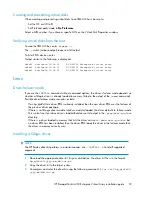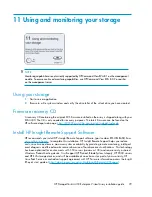
•
For Solaris 8/9, install the latest Sun StorEdge SAN software with associated patches. To automate
the installation, use the Sun-supplied install script available at:
1.
Under Systems Administration, select
Storage Management
.
2.
Under Browse Products, select
StorageTek SAN 4.4
.
3.
Reboot the host after the required software/patches have been installed. No further activity
is required after adding any new LUNs once the array ports have been configured with the
cfgadm –c
command for Solaris 8/9.
Examples for two FCAs:
cfgadm -c configure c3
cfgadm -c configure c4
•
For Solaris 10, use the Sun Update Manager to install the latest patches (see
). Reboot the host once the required software/patches have been installed.
No further activity is required after adding any new LUNs, as the controller and LUN recognition
is automatic for Solaris 10.
Configuring Emulex FCAs with the lpfc driver
To determine which Emulex FCAs and which driver version HP supports with the lpfc driver, see the
latest
HP StorageWorks 4400 Enterprise Virtual Array release notes
or contact your HP representative.
To configure Emulex FCAs with the lpfc driver:
•
Ensure that you have the latest supported version of the lpfc driver (see
).
•
Edit the following parameters in the
/kernel/drv/lpfc.conf
driver configuration file to set
up the FCAs for a SAN infrastructure:
topology=2;
scan-down=0;
nodev-tmo=60;
linkdown-tmo=60;
•
If using a single FCA and no multipathing, edit the following parameter to reduce the risk of data
loss in case of a controller reboot:
nodev-tmo=120;
•
If using Veritas Volume Manager (VxVM) DMP for multipathing (single or multiple FCAs), edit the
following parameter to ensure proper VxVM behavior:
no-device-delay=0;
•
In a fabric topology, you use persistent bindings to bind a SCSI target ID to the world wide port
name (WWPN) of an array port. This ensures that the SCSI target IDs remain the same when the
system reboots. You set persistent bindings by editing the configuration file or by using the
lputil
utility.
NOTE:
HP recommends that you assign target IDs in sequence, and that the EVA has the same target ID
on each host in the SAN.
The following example for an EVA4400 illustrates the binding of targets 20 and 21 (lpfc instance
2) to WWPNs 50001fe100270938 and 50001fe100270939, and the binding of targets 30
and 31 (lpfc instance 0) to WWPNs 50001fe10027093a and 50001fe10027093b:
HP StorageWorks 4400 Enterprise Virtual Array installation guide
67
Summary of Contents for StorageWorks 4400
Page 16: ...Figure 4 Installation checklist cont d About this guide 16 ...
Page 20: ...Review and confirm your plans 20 ...
Page 24: ...Remove product from packaging 24 ...
Page 36: ...Connect cables and power cords 36 ...
Page 48: ...Configuring management servers using HP SmartStart EVA Storage 48 ...
Page 50: ...Configuring application servers for Windows using HP SmartStart EVA Storage 50 ...
Page 78: ...Configuring non Windows application servers 78 ...






























